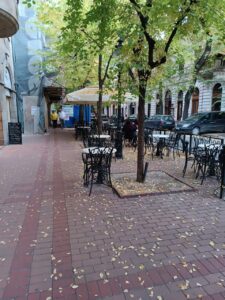Historical heritage of different ethnic groups in Subotica.
Subotica, a picturesque city located in northern Serbia, is renowned for its rich historical heritage shaped by a mosaic of ethnic groups. Over the centuries, various communities have settled in this region, each contributing to the cultural, architectural, and social fabric of the city. The interplay of these diverse influences has created a unique identity for Subotica, making it a fascinating case study of multiculturalism in the Balkans. This article explores the historical heritage of different ethnic groups in Subotica, highlighting their contributions and the lasting impact they have had on the city.
Historical Heritage of the Hungarian Community
The Hungarian community is one of the most prominent ethnic groups in Subotica, with a history that dates back to the medieval period. Following the Austro-Hungarian Empire’s expansion in the 19th century, Subotica became a significant center for Hungarian culture and politics. The community’s influence is evident in the city’s architecture, particularly in the stunning Art Nouveau buildings that adorn the cityscape, such as the Raichle Palace and the City Hall. These structures not only showcase the artistic achievements of the time but also reflect the aspirations of the Hungarian population in Subotica.
In addition to architecture, the Hungarian community has made substantial contributions to the local cultural scene. Traditional festivals, music, and dance are integral to Subotica’s identity, with events such as the Hungarian Cultural Days celebrating the community’s heritage. The preservation of the Hungarian language and literature is also a priority, with schools and cultural institutions dedicated to fostering this aspect of their identity. The community’s commitment to maintaining its traditions has ensured that Hungarian culture remains vibrant and influential in Subotica today.
Moreover, the historical relationship between the Hungarian community and other ethnic groups in Subotica has shaped the city’s social dynamics. While there have been periods of tension, particularly during the tumultuous events of the 20th century, the Hungarian community has often engaged in dialogue and collaboration with other groups, fostering a spirit of coexistence. This interplay has enriched Subotica’s cultural landscape, making it a testament to the resilience and adaptability of its diverse population.
Historical Heritage of the Serbian Community
The Serbian community in Subotica has a long and storied history, with roots that trace back to the medieval era. As the city evolved, so did the Serbian presence, particularly during the 19th century when many Serbs migrated to Subotica in search of economic opportunities. The Serbian Orthodox Church has played a pivotal role in the community’s development, with the Church of St. Teresa of Avila serving as a significant landmark. This architectural gem not only reflects the religious devotion of the Serbian population but also stands as a symbol of their cultural identity.
Culturally, the Serbian community has contributed to Subotica’s rich tapestry through various artistic expressions, including literature, music, and folklore. Traditional Serbian festivals, such as Slava, are celebrated with great enthusiasm, showcasing the community’s customs and values. The preservation of the Serbian language and the promotion of local literature have also been vital in maintaining a strong cultural identity. Institutions such as the Serbian Cultural Center serve as hubs for artistic expression and community engagement, fostering a sense of belonging among Serbs in Subotica.
The historical interactions between the Serbian community and other ethnic groups have significantly influenced Subotica’s social landscape. While there have been challenges, particularly during periods of conflict, the Serbian community has often sought to build bridges with other groups, emphasizing the importance of unity and cooperation. This collaborative spirit has allowed Subotica to thrive as a multicultural city, where diverse traditions coexist and enrich the overall cultural experience.
Historical Heritage of the Croatian Community
The Croatian community in Subotica has a rich history that dates back to the 18th century, when Croats began settling in the region as part of the Habsburg Empire’s efforts to populate the area. This community has made significant contributions to Subotica’s cultural and social life, particularly through its vibrant traditions and customs. The Church of St. Nicholas, a prominent landmark in the city, serves as a testament to the Croatian community’s religious and cultural heritage, providing a space for worship and community gatherings.
Culturally, the Croatian community has maintained its identity through various artistic expressions, including folk music, dance, and traditional crafts. Events such as the Croatian Cultural Festival highlight the community’s rich heritage, showcasing traditional costumes, music, and culinary delights. The preservation of the Croatian language is also a priority, with educational institutions and cultural organizations dedicated to promoting linguistic and cultural education among younger generations. This commitment to cultural preservation has ensured that the Croatian community remains an integral part of Subotica’s identity.
The historical interactions between the Croatian community and other ethnic groups in Subotica have fostered a spirit of cooperation and mutual respect. While there have been challenges, particularly during periods of political upheaval, the Croatian community has often engaged in dialogue with other groups, emphasizing the importance of coexistence. This collaborative approach has contributed to Subotica’s reputation as a multicultural city, where diverse traditions and cultures are celebrated and respected.
Subotica’s historical heritage is a testament to the city’s rich tapestry of ethnic diversity, with each community contributing to its unique identity. The Hungarian, Serbian, and Croatian communities, among others, have left an indelible mark on the city’s cultural landscape through their traditions, architecture, and social interactions. As Subotica continues to evolve, the preservation and celebration of this multicultural heritage remain essential for fostering understanding and cooperation among its diverse population. The city’s history serves as a reminder of the strength found in diversity, making Subotica a vibrant example of multicultural coexistence in the Balkans.


